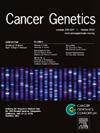Occult collision tumor of the gastroesophageal junction comprising adenocarcinomas with distinct molecular profiles
IF 2.1
4区 医学
Q4 GENETICS & HEREDITY
引用次数: 0
Abstract
Collision tumors, characterized by the coexistence of two unique neoplasms in close approximation, are rare and pose diagnostic challenges. This is particularly true when the unique neoplasms are of the same histologic type. Here we report such a case where comprehensive tumor profiling by next generation sequencing (NGS) as well as immunohistochemistry revealed two independent adenocarcinomas comprising what was initially diagnosed as a single adenocarcinoma of the gastroesophageal (GEJ) junction. Biopsy of the esophageal portion of the GEJ mass showed a mismatch repair deficient tumor with loss of immunoreactivity for MLH1 and PMS2, while the biopsy taken from the gastric portion of the mass revealed a separate tumor with a discordant, non-overlapping, set of molecular alterations, including an EML4::ALK fusion, as well as intact MMR. This case illustrates one way in which NGS can reveal diagnoses such as collision tumor that are wholly unexpected based on clinical and histological grounds. Such diagnoses can have important implications for patient care, particularly in cases where there is discordance for targetable molecular alterations.
胃食管交界处隐匿性碰撞瘤,包括具有不同分子谱的腺癌。
碰撞肿瘤的特点是两种独特的肿瘤在接近的共存,是罕见的,并提出了诊断的挑战。当独特的肿瘤具有相同的组织学类型时尤其如此。在这里,我们报告了这样一个病例,通过下一代测序(NGS)和免疫组织化学的综合肿瘤分析显示了两个独立的腺癌,包括最初诊断为胃食管(GEJ)连接处的单个腺癌。GEJ肿块食管部分的活检显示错配修复缺陷肿瘤,MLH1和PMS2的免疫反应性丧失,而肿块胃部分的活检显示一个单独的肿瘤,具有不一致、不重叠的一组分子改变,包括EML4::ALK融合,以及完整的MMR。该病例说明了NGS可以揭示基于临床和组织学基础完全意想不到的碰撞瘤等诊断的一种方法。这样的诊断对病人的护理有重要的意义,特别是在靶向分子改变不一致的情况下。
本文章由计算机程序翻译,如有差异,请以英文原文为准。
求助全文
约1分钟内获得全文
求助全文
来源期刊

Cancer Genetics
ONCOLOGY-GENETICS & HEREDITY
CiteScore
3.20
自引率
5.30%
发文量
167
审稿时长
27 days
期刊介绍:
The aim of Cancer Genetics is to publish high quality scientific papers on the cellular, genetic and molecular aspects of cancer, including cancer predisposition and clinical diagnostic applications. Specific areas of interest include descriptions of new chromosomal, molecular or epigenetic alterations in benign and malignant diseases; novel laboratory approaches for identification and characterization of chromosomal rearrangements or genomic alterations in cancer cells; correlation of genetic changes with pathology and clinical presentation; and the molecular genetics of cancer predisposition. To reach a basic science and clinical multidisciplinary audience, we welcome original full-length articles, reviews, meeting summaries, brief reports, and letters to the editor.
 求助内容:
求助内容: 应助结果提醒方式:
应助结果提醒方式:


